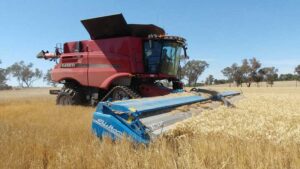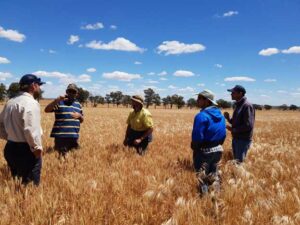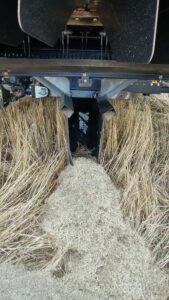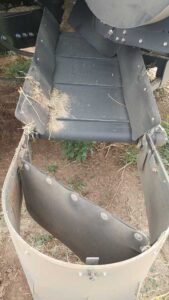By Drew Lyon
I’ve spent a good deal of my time in recent years working on herbicide resistance, observing in real time as Eastern Washington wheat growers lose effective herbicides as resistance in weeds, including Italian ryegrass and downy brome, grows.
The phenomenon is not limited to this region. The Midwest is well ahead of the Pacific Northwest in confronting herbicide resistance. But it is Australia that faces what may be the most daunting herbicide resistance issues in the world.
As a result, Australian wheat growers have had to think outside of the box to address resistance issues. This includes using non-chemical approaches to manage herbicide-resistant weed populations. One that I find particularly interesting is called Harvest Weed Seed Control (HWSC).
HWSC is an innovative, non-chemical approach that takes advantage of seed retention of the plant at maturity in many dominant annual weed species.
I connected with Dr. Michael Walsh, currently with the University of Sydney, shortly after arriving in Pullman in 2012. Dr. Walsh has been a leader in HWSC and he served as my mentor on the topic. In October and November 2018, I spent seven weeks in Australia with Dr. Walsh on a visiting professorship from the University of Sydney to learn more about HWSC.
There is high weed seed retention at crop maturity by dominant annual weeds in Australian cropping systems. Under normal conditions, these seeds are collected, threshed, separated from the grain, and expelled from the combine in the chaff fraction during harvest. The chaff material containing weed seed is then spread back across the harvest swath, a process that often results in seeding hundreds of thousands of seed.
Disrupting this process is the goal of several HWSC systems that have been developed. By targeting the chaff fraction during harvest, reseeding of weeds contained in the chaff, can be prevented.
I have used funds from my Washington Grain Commission Endowed Chair fund to support research on narrow-windrow burning and weed seed retention in Italian ryegrass. Recent studies on seed retention of Italian ryegrass were not promising. I found in winter wheat that site conditions, such as slope position, influenced the rate of seed shattering in Italian ryegrass, with less than 50 percent of the seed remaining in the head at wheat maturity.
Consequently, HWSC has low to intermediate potential for the management of Italian ryegrass in winter wheat. However, preliminary data suggests that Italian ryegrass seed retention at harvest may be greater in spring wheat than in winter wheat. In work conducted in northeast Oregon, Dr. Judit Barroso found that downy brome seed retention at harvest varied widely (Table), with retention rates being higher at wetter, cooler sites than at drier, warmer sites. Cereal rye (aka feral rye) was also found to be a good candidate species for HWSC in the PNW.
Table. Seed-retention at harvest for weeds of concern in wheat production systems of the inland Pacific Northwest.
Weed species | Seed retention (%) | Harvest weed seed control potential |
|---|---|---|
Cereal rye | 49 – 61 | Intermediate |
Downy brome | 25 – 87 | Low to high |
Italian ryegrass | 27 – 50 | Low to intermediate |
Jointed goatgrass* | > 75 | Intermediate |
Rattail fescue | 11 – 90 | Low to high |
Wild oat* | 39 | Low |
*Data from the Great Plains (Walsh et al., 2018).
Narrow-windrow burning is currently the most commonly used HWSC system in Australia. With this practice, a chute is attached to the rear of the combine that concentrates the chaff and straw into a 20- to 24-inch windrow. These windrows are subsequently burned when environmental conditions are favorable.
Research in Australia and Eastern Washington has shown that 99 percent of annual ryegrass seed in the windrow is destroyed by this method. However, this system has several drawbacks including the destruction of crop residues critical for collecting and retaining soil water, reducing soil erosion, and promoting soil health. The practice also results in smoke, which poses health and safety issues.
The bale direct system uses a large square baler attached directly behind the combine that builds bales from the chaff, which contains the weed seeds, and straw exiting the combine. This system requires available markets for the baled material. Furthermore, there are concerns over removing too much crop residue, which is a source for both carbon and plant nutrients, not to mention possible spreading of weed seeds as bales move on roads and highways.
The development and integration of impact mills, such as the integrated Harrington Seed Destructor or the Redekop MAV Seed Control Unit, into the rear of combines, has shown great promise for processing the chaff during harvest to sufficiently control weed seeds. For many growers, however, the cost of purchasing and operating the equipment is prohibitively high. It is likely, however, that as development continues and costs come down, this may be the preferred HWSC system.
Chaff lining and chaff tramlining are two other low-cost HWCS systems that are rapidly gaining popularity in Australia. Attachments at the rear of the combine collect and place chaff into 10- to 12-inch rows, either between stubble rows directly behind the combine (chaff lining) or in the wheel tracks (chaff tramlining). Although controlled traffic allows chaff lines to be placed in the same spot every year, it is not critical to the success of chaff lining, although it is required for chaff tramlining.
Concentrating the chaff in narrow rows creates a hostile environment for weed seed germination and emergence. Those weeds that do emerge and grow are concentrated in the narrow rows where they compete with each other, thus reducing seed production, and affect less of the crop area. Subsequent weed control efforts, if required, can be concentrated on these narrow strips in the field. Chaff tramlining places the seed in the wheel rows where the soil is compacted, making growth and development even more difficult.
Perhaps the most significant change in weed management strategy in Australia has been a shift to focus on reducing the weed seed bank and maintaining low seed bank levels by whatever means possible. They call this a ‘zero tolerance policy’ or a ‘take no prisoners’ approach.
This approach runs contrary to that advocated for many years – and still effectively used for insect and disease control – of using economic thresholds to determine if weed density is great enough to warrant the expense of applying an herbicide or using tillage. However, because the likelihood of selecting for herbicide resistance in a weed population increases as the number of plants treated with a particular herbicide increases, keeping weed numbers as low as possible reduces the chances for selecting a resistant weed biotype.
The experience in Australia over the past decade has shown that minimizing seed set or seed bank replenishment to sustain low weed seed bank levels is critical for profitable grain crop production. Harvest weed seed control is a new tool that can help manage weed seed bank levels in Eastern Washington.
For more information on harvest weed seed control see ‘Harvest Weed Seed Control: Applications for PNW Wheat Production Systems’ (https://pubs.extension.wsu.edu/harvest-weed-seed-control-applications-for-pnw-wheat-production-systems) available on the Herbicide Resistance Resources page (http://smallgrains.wsu.edu/herbicide-resistance-resources) on the Wheat and Small Grains website (http://smallgrains.wsu.edu).




